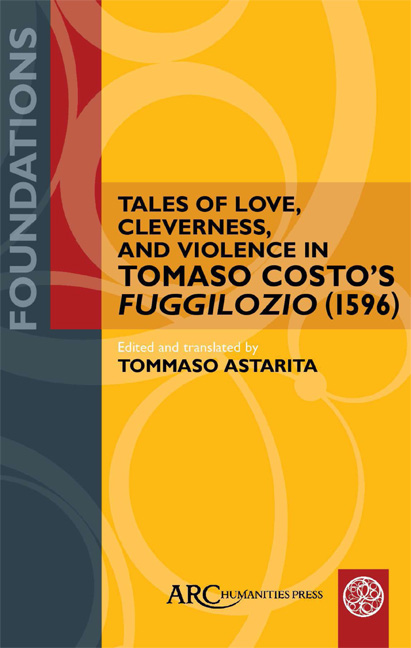Introduction
Published online by Cambridge University Press: 08 May 2024
Summary
TOMASO COSTO (CA. 1545-probably 1613) was a Neapolitan literary scholar and author. He was involved with various elite literary and social circles in Naples-then the largest city in Italy-and published poems, historical works, essays and dialogues, biographies, letters, and other works. Il Fuggilozio (“The Cure for Indolence”) first appeared in Naples in 1596, and was republished numerous times in Venice, starting in 1600. At least sixteen editions appeared by 1700. The title defines the book as a tool to escape, or chase away, ozio, idle leisure that can have morally corrupting effects. The book offers to chase that away through entertainment that is both agreeable and wholesome, indeed morally improving.
Costo's Naples
Naples in the late sixteenth century was the capital of a kingdom that since 1503 had been held by the King of Spain (together with the island kingdoms of Sicily and Sardinia). The kingdom was the largest state in Italy, then divided into numerous principalities and republics, and Naples, with about 300,000 inhabitants around 1600, was by far the largest city in the peninsula (and one of the two or three largest in Christian Europe). The kingdom was not rich, and many of its provinces were indeed quite poor, dominated by traditional and, on the whole, unproductive agriculture. But the capital city was rich and lively. It housed the viceroy, almost always a Spanish aristocrat who governed in the king's name, and a substantial bureaucracy, with numerous administrative, financial, and judicial bodies staffed by a large professional class. Many of these bureaucrats, judges, and administrators were trained in the university founded in Naples in 1224, which was then, and would long remain, the only university in the Italian South. The city government, under the watchful eye of the viceroys, was run mainly by the city's old noble elite, with rich professional and mercantile families holding a secondary role within it. In addition to its old urban nobility, Naples also attracted rich aristocratic families from all over the Italian South, whose wealth came generally from large landed (and often feudal) estates in the kingdom's provinces, but most of whom, by the late sixteenth century, spent a substantial part of their time and money in the capital.
- Type
- Chapter
- Information
- Tales of Love, Cleverness, and Violence in Tomaso Costo's Fuggilozio (1596)Translated into English, pp. 11 - 22Publisher: Amsterdam University PressPrint publication year: 2024

